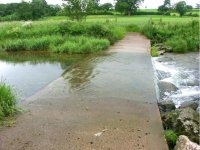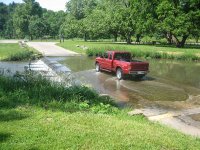Boondox
Elite Member
- Joined
- Apr 6, 2000
- Messages
- 3,871
- Location
- Craftsbury Common, Vermont
- Tractor
- Deere 4044R cab, Kubota KX-121-3S
I've studied the threads on installing culverts, but none appear to have the same challenges I face. I have a 10 foot long 24 inch diameter culvert that is (a) a tad too small to handle the seasonal volume of water that flows in the stream, and (b) too short to permit a sufficient amount of fill to drive my tractor or excavator safely across. Unfortunately, my woodlot is on the other side of the stream.
I'm going to replace it with a 20 foot long 36 inch diameter double walled culvert that will allow me to build the crossing up with fill, which I have plenty of. I have two challenges:
1) With water constantly flowing (on a dry day it's two feet wide and a couple inches deep), will it be possible to spread and pack down a stone base?
2) The approach is very narrow. In a perfect world I would be able to use the tractor bucket to hold the new culvert in place while adding fill, but there's barely enough room for the excavator as it is. Is there another way of preventing the culvert from shifting as the fill is placed around it?
Advice welcomed.
Pete
I'm going to replace it with a 20 foot long 36 inch diameter double walled culvert that will allow me to build the crossing up with fill, which I have plenty of. I have two challenges:
1) With water constantly flowing (on a dry day it's two feet wide and a couple inches deep), will it be possible to spread and pack down a stone base?
2) The approach is very narrow. In a perfect world I would be able to use the tractor bucket to hold the new culvert in place while adding fill, but there's barely enough room for the excavator as it is. Is there another way of preventing the culvert from shifting as the fill is placed around it?
Advice welcomed.
Pete



